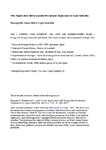Mostrar o rexistro simple do ítem
Rapid Colour Shift by Reproductive Character Displacement in Cupido Butterflies
| dc.contributor.author | Hinojosa, Joan C. | |
| dc.contributor.author | Koubínová, Darina | |
| dc.contributor.author | Dincă, Vlad Eugen | |
| dc.contributor.author | Hernández-Roldán, Juan | |
| dc.contributor.author | Munguira, Miguel | |
| dc.contributor.author | García-Barros, Enrique | |
| dc.contributor.author | Vila, Marta | |
| dc.contributor.author | Álvarez, Nadir | |
| dc.contributor.author | Mutanen, Marko | |
| dc.contributor.author | Vila, Roger | |
| dc.date.accessioned | 2024-01-24T21:03:44Z | |
| dc.date.available | 2024-01-24T21:03:44Z | |
| dc.date.issued | 2020-10-13 | |
| dc.identifier.citation | Hinojosa JC, Koubínová D, Dincă V, et al. Rapid colour shift by reproductive character displacement in Cupido butterflies. Mol Ecol. 2020; 29: 4942–4955. https://doi.org/10.1111/mec.15682 | es_ES |
| dc.identifier.issn | 1365-294X | |
| dc.identifier.uri | http://hdl.handle.net/2183/35131 | |
| dc.description | This is the peer reviewed version of the article, which has been published in final form https://doi.org/10.1111/mec.15682 | es_ES |
| dc.description.abstract | [Abstract] Reproductive character displacement occurs when competition for successful breeding imposes a divergent selection on the interacting species, causing a divergence of reproductive traits. Here, we show that a disputed butterfly taxon is actually a case of male wing colour shift, apparently produced by reproductive character displacement. Using double digest restriction-site associated DNA sequencing and mitochondrial DNA sequencing we studied four butterfly taxa of the subgenus Cupido (Lepidoptera: Lycaenidae): Cupido minimus and the taxon carswelli, both characterized by brown males and females, plus C. lorquinii and C. osiris, both with blue males and brown females. Unexpectedly, taxa carswelli and C. lorquinii were close to indistinguishable based on our genomic and mitochondrial data, despite displaying strikingly different male coloration. In addition, we report and analysed a brown male within the C. lorquinii range, which demonstrates that the brown morph occurs at very low frequency in C. lorquinii. Such evidence strongly suggests that carswelli is conspecific with C. lorquinii and represents populations with a fixed male brown colour morph. Considering that these brown populations occur in sympatry with or very close to the blue C. osiris, and that the blue C. lorquinii populations never do, we propose that the taxon carswelli could have lost the blue colour due to reproductive character displacement with C. osiris. Since male colour is important for conspecific recognition during courtship, we hypothesize that the observed colour shift may eventually trigger incipient speciation between blue and brown populations. Male colour seems to be an evolutionarily labile character in the Polyommatinae, and the mechanism described here might be at work in the wide diversification of this subfamily of butterflies. | es_ES |
| dc.description.sponsorship | Financial support for this research was provided by projects CGL2016-76322-P (AEI/ERDF, EU), PID2019-107078GB-I00 (AEI/10.13039/501100011033) and 2017-SGR-991 (Generalitat de Catalunya) to Roger Vila, by the Academy of Finland to Vlad Dincă (Academy Research Fellow, decision no. 328895) and Marko Mutanen (decision no. 277984), and by predoctoral fellowship BES-2017-080641 to Joan Carles Hinojosa | es_ES |
| dc.description.sponsorship | Generalitat de Catalunya; 2017-SGR-991 | es_ES |
| dc.description.sponsorship | Academy of Finland; 328895 | es_ES |
| dc.description.sponsorship | Academy of Finland; 277984 | es_ES |
| dc.language.iso | eng | es_ES |
| dc.publisher | Wiley | es_ES |
| dc.relation | info:eu-repo/grantAgreement/AEI/Plan Estatal de Investigación Científica y Técnica y de Innovación 2013-2016/CGL2016-76322-P/ES/GENOMICA DE LA ESPECIACION EN ORGANISMOS NOMODELO: EXPLORANDO EL CONTINUO DE DIVERSIFICACION EN LAS MARIPOSAS EUROPEAS/ | es_ES |
| dc.relation | info:eu-repo/grantAgreement/AEI/Plan Estatal de Investigación Científica y Técnica y de Innovación 2017-2020/PID2019-107078GB-I00/ES/GENOMICA DE LA ESPECIACION EN MARIPOSAS/ | es_ES |
| dc.relation | info:eu-repo/grantAgreement/AEI/Plan Estatal de Investigación Científica y Técnica y de Innovación 2017-2020/BES-2017-080641/ES/ | es_ES |
| dc.relation.uri | https://doi.org/10.1111/mec.15682 | es_ES |
| dc.rights | © 2020 John Wiley & Sons Ltd. This article may be used for non-commercial purposes in accordance with Wiley Terms and Conditions for Use of Self-Archived Versions. This article may not be enhanced, enriched or otherwise transformed into a derivative work, without express permission from Wiley or by statutory rights under applicable legislation. Copyright notices must not be removed, obscured or modified. The article must be linked to Wiley’s version of record on Wiley Online Library and any embedding, framing or otherwise making available the article or pages thereof by third parties from platforms, services and websites other than Wiley Online Library must be prohibited. | es_ES |
| dc.subject | Reproductive character displacement | es_ES |
| dc.subject | Reinforcement | es_ES |
| dc.subject | Speciation | es_ES |
| dc.subject | Lepidoptera | es_ES |
| dc.subject | RAD-sequencing | es_ES |
| dc.title | Rapid Colour Shift by Reproductive Character Displacement in Cupido Butterflies | es_ES |
| dc.type | info:eu-repo/semantics/article | es_ES |
| dc.rights.access | info:eu-repo/semantics/openAccess | es_ES |
| UDC.journalTitle | Molecular Ecology | es_ES |
| UDC.volume | 29 (2020) | es_ES |
| UDC.issue | 24 (December) | es_ES |
| UDC.startPage | 4942 | es_ES |
| UDC.endPage | 4955 | es_ES |
| dc.identifier.doi | 10.1111/mec.15682 |
Ficheiros no ítem
Este ítem aparece na(s) seguinte(s) colección(s)
-
GI-GIBE - Artigos [84]






